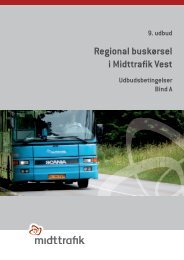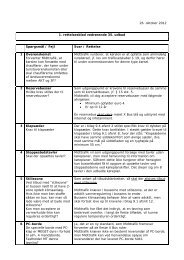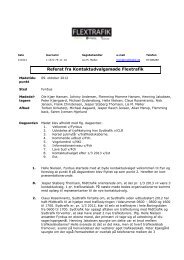Storskalaprojekt med forsyning af AFME biodiesel i ... - Trafikstyrelsen
Storskalaprojekt med forsyning af AFME biodiesel i ... - Trafikstyrelsen
Storskalaprojekt med forsyning af AFME biodiesel i ... - Trafikstyrelsen
Create successful ePaper yourself
Turn your PDF publications into a flip-book with our unique Google optimized e-Paper software.
ased product used. Oil companies have to deal with a complex problem, both with<br />
respect to purchasing of base diesel and <strong>biodiesel</strong>, in the event that this is not<br />
purchased ready blended from refineries and also with respect to the exchange of<br />
products between oil companies (exchange agreements).<br />
The adjustment of storage facilities and ensuing running, including use of biocomponents<br />
has gone well. The work was greater and more complicated than<br />
expected, but has led to valuable information on the future organisation and<br />
management of storage of bio-component blended products, in the event that oil<br />
companies choose a decentralised blending practice. This includes also the<br />
administrative management of bio-components with respect to tax and excise.<br />
Different solutions were used for the two storage facilities in the project, depending on<br />
the construction in question, but were chosen with respect to existing systems.<br />
Common to both were that a two-step blending system was used, with establishment<br />
of a 50/50% tank, followed by a blending to B5 on the delivery ramp. Heating of the<br />
<strong>biodiesel</strong> was also used, although the methods and equipment for heating and<br />
insulation of tanks and pipes were different. The control systems for exact blending on<br />
the ramps are also different, but both systems functioned effectively.<br />
It was decided relatively late in the project preparation phase, to go from one-step to<br />
two-step blending to ensure the best possible blending during winter, where base<br />
diesel can be chilled to around 0 degrees in the storage tanks. The decision to change<br />
to a two-step system changed markedly the budget and time plan for conversion of<br />
the storage facilities. On top of this, handling of <strong>biodiesel</strong> and use of a new base diesel<br />
product both contributed to complicate the process, including changes to the use of<br />
existing tanks and requirements for approval. The need to complete conversion of<br />
storage facilities quickly, so that distribution could be started in the winter months,<br />
contributed to making the construction relatively expensive. Despite this, conversion<br />
has carried out successfully and the oil companies have only minor changes with<br />
respect to future use of these storage units.<br />
In the daily use of the storage facilities, it is now clear that processes and<br />
administration can be run by the oil companies themselves, although it is generally<br />
more demanding, not least with respect for ensuring that product specifications and<br />
standards are maintained. In this way, problems with respect to the cold weather<br />
performance were solved by heating and insulating parts of the systems. Procedures<br />
and a concrete warning system for co-operation between <strong>biodiesel</strong> suppliers and<br />
storage facilities were created, in order to handle the heated <strong>biodiesel</strong> most<br />
effectively. Procedures with respect to blending of the fossil fuel and bio-component<br />
have led to restrictions in supply of fuels and increased demands for planning.<br />
There have been no problems with distribution from storage facilities to end users via<br />
commercial petrol stations and to fleet owners. With respect to current guidelines for<br />
handling of bio-components and based on the experience of oil companies in other<br />
countries, a thorough cleaning of all storage tanks was carried out beforehand.<br />
Cleaning of the tanks was carried out by the oil companies themselves and partly<br />
covered under current legal responsibilities regarding regular inspection checks. On<br />
completion of the test, samples were taken for evaluation of water content in the<br />
4

















